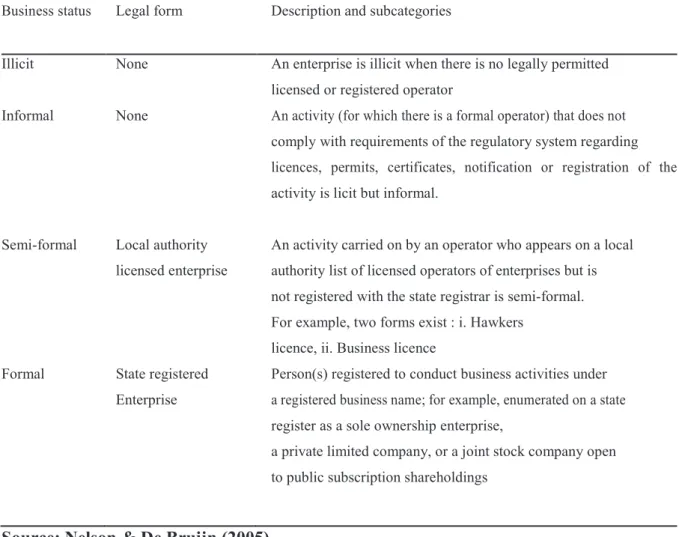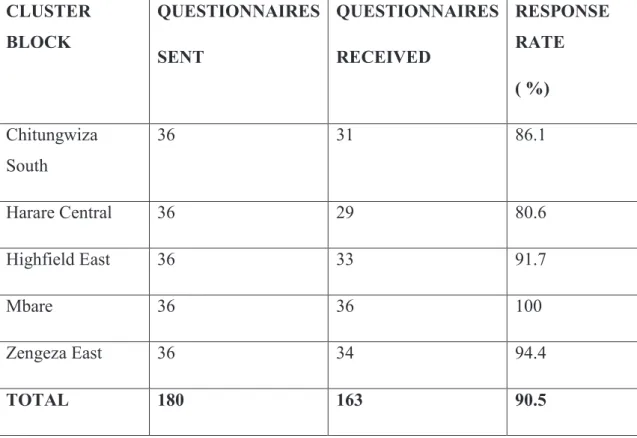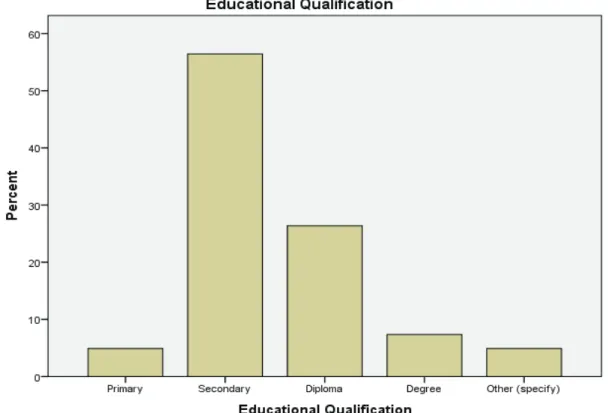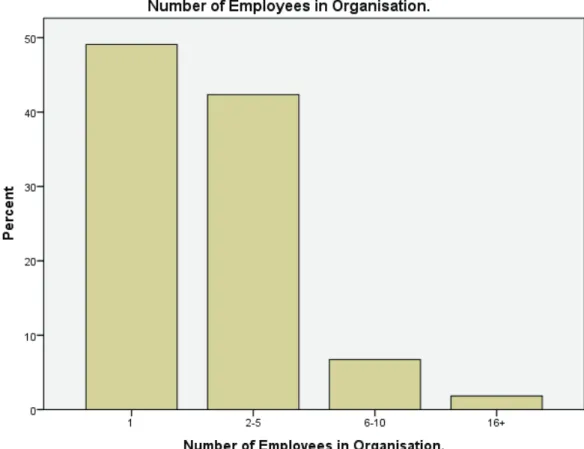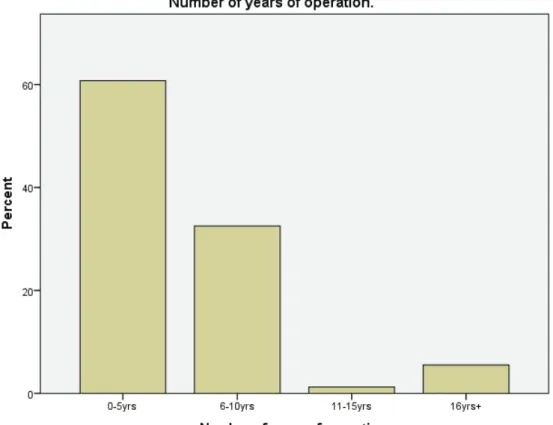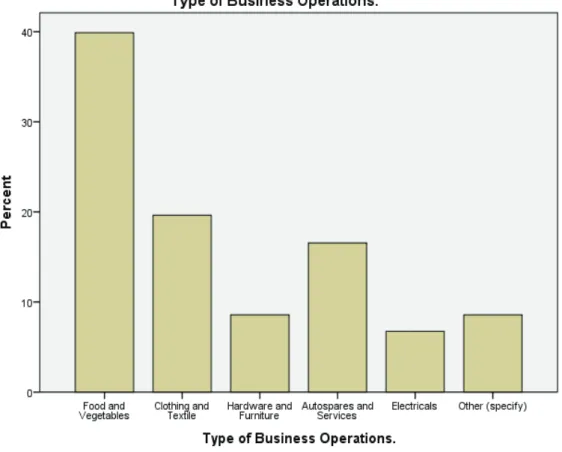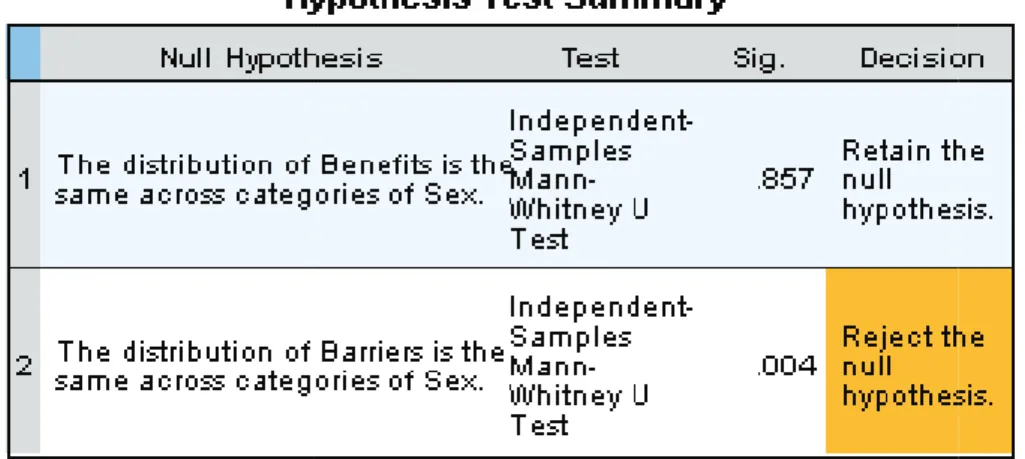Factor analysis was used to extract the dimensions of barriers and benefits of formalization. The main findings were that while informal entrepreneurs in the Harare Metropolitan area appreciated the benefits of formalization, they lamented the existence of regulatory, bureaucratic and administrative barriers to formalization.
INTRODUCTION
BACKGROUND
Overview
Background to the Industry
Background to Informal Entrepreneurship and Formalisation in Harare
The recent tabling in Parliament of the Financial Adjustment Bill, which seeks to formalize the informal sector in Zimbabwe, has sparked an interesting debate. There is a wide literature on the formalization of the informal economy, and views on the benefits, barriers and methods of formalization vary.
STATEMENT OF THE PROBLEM
This study therefore seeks to fill this apparent research gap by analyzing the activities of informal entrepreneurs and stimulate debate among policy makers and stimulate reflection on the socio-economic benefits of formalizing their businesses. There is a need to better understand the most effective ways to tackle the informal economy in order to choose the best approach to formalization.
RESEARCH OBJECTIVES
Also, little research work has been done to establish the links between the benefits of formalization and the decision to formalize informal businesses. The research examines the changing linkages and how authorities can best support informal entrepreneurs to formalize their businesses.
RESEARCH QUESTIONS
SIGNIFICANCE OF THE STUDY
THE SCOPE OF STUDY
DISSERTATION OUTLINE
CHAPTER SUMMARY
A statement of the importance and urgency of the study is given, indicating the importance of the study to both government and academia. Next is the scope of the study, which delineates the geographic distribution, population, and sample of the study.
INTRODUCTION
THE INFORMAL SECTOR
Theories Underpinning the Study
The Legalist School sees the informal sector as composed of micro-entrepreneurs who choose to work informally to avoid the cost, time and effort of formal government registration (Chen, 2012; Mbiriri, 2010). Finally, the Structuralist School sees the informal sector as a strong association between the formal and the informal economies.
Causes of Informal Sector
They would deliberately operate informally to avoid the cumbersome processes they blame on the authorities (Mitullah Dzhekova & Williams, 2014). The second view is based on voluntarism where people are said to engage in informal entrepreneurship out of choice, such as to set their careers on a new path, transform their work identity or revise their true selves (Maloney, 2004; Snyder, 2004). third view depicts that informal entrepreneurs can be both necessity and opportunity driven depending on the ratio of opportunity to necessity (Edcomb & Thetford, 2004; Valenzuela, 2002).
Importance of the Informal Sector
TYPES AND STATUS OF FORMALITY
There are others who have been able to obtain a license from the local government, making them semi-formal. For the purposes of this study, both informal and semi-formal business status are considered as informal entrepreneurship as they are not registered to carry out economic activities in a government register as a private limited company or limited liability company within the meaning of the law.
BENEFITS OF FORMALISATION OF BUSINESS
Others suggest that formalizing their businesses would orient them toward upgrading operations and growing the business, realizing the economic growth trapped in the informal economy (USAID, 2005). A study conducted in Latin America found empirical evidence that an increase in the size of the informal sector reduced economic growth, as it reduced the availability of public services to everyone in business, but at the same time increased the number of players that made inefficient use of public services (Ishengoma, 2006).
BARRIERS TO FORMALISATION OF BUSINESS
- Regulatory Barriers
- Administrative Barriers
- Business Fees and Financial (Costs) Barriers
- Other Barriers
Spiegel (2012) has a different view on the obstacles to formalization in the informal gold mining sector. BENEFITS OF FORMALIZATION OBSTACLES TO FORMALIZATION Higher quality, better paid and more sustainable jobs for.
ENABLERS TO FORMALISATION
Williams and Nadin (2013) state that a service-oriented approach, which includes initiatives to provide microfinance, better infrastructure and other supports, is expected to create a push for formalization. He argues that the second approach includes initiatives such as business registration reform and simplified tax administration, which have a drag effect. They emphasize the need to start a dialogue with the participants in the informal sector to understand their constraints, needs and perspectives.
CASES OF PRACTICAL INITIATIVES
The Bulgarian experience introduced the introduction of preventive and curative measures that promote commitment in tackling the informal economy. The deterrence of entry into the informal sector was pursued through compulsory registration of employment contracts and compulsory minimum income. However, this did not lead to the intended reduction of the informal activities, but instead increased (European Commission, 2007).
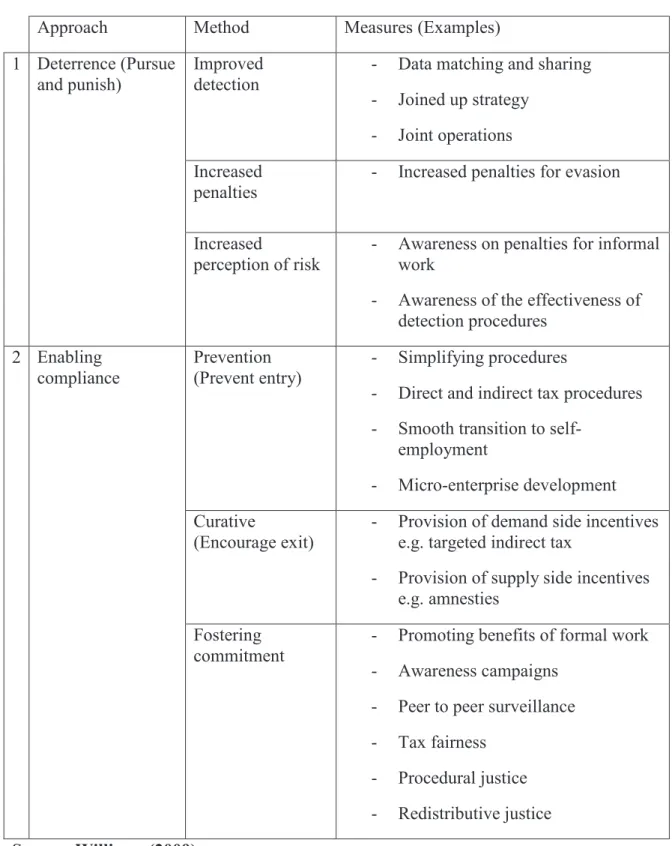
THE RESEARCH FRAMEWORK AND PROPOSITION
The Research Proposition
The main proposition of the study is that the perceived barriers and benefits of formalization influence their willingness to formalize their business activities. H3: The distribution of perceived benefits and barriers to formalization is the same across positions in the company.
CHAPTER SUMMARY
INTRODUCTION
RESEARCH DESIGN
Research Philosophy
The approach allowed the establishment of the relationship between the variables "barriers to formalization, business formalization and benefits of formalization". The approach's high reliability, efficiency of data and high accuracy are some of the advantages that spurred the adoption of the paradigm. The approach was more suitable to ensure that the research question and objectives are achieved (Bryman, 2007) as it answers the questions what, where, how, when and why.
Research Strategy
Quantitative techniques mainly use data collection and data analysis procedures that generate or use numbers while qualitative techniques generate or use non-numerical data (Saunders, et al., 2009. p. 151). It also allows sampling that generates findings that are representative of the entire population at a reduced cost. In addition to administering a structured questionnaire as a data collection technique, structured interviews were used where standardized questions were asked of all respondents.
POPULATION AND SAMPLING TECHNIQUES
Population
Sampling
SOURCES OF DATA
DATA COLLECTION PROCEDURE (RESEARCH INSTRUMENTS)
A self-administered (delivery and collection) questionnaire was chosen as it best suited the research questions, objectives and the limited resources available. The questionnaire was designed keeping in mind the data needed to answer the research questions and meet the objectives. The data were first assessed for suitability to check whether they answered the research questions and met the stated objectives.
DATA ANALYSIS
Demographics were analyzed using descriptive statistics, while factor analysis methods were used to measure different aspects of the same underlying variable (Darlington, 2004). Intercorrelations between variables were looked at to check whether test questions measured the same underlying dimension. As part of the main factor analysis, a correlation matrix was created, after which the analysis was performed on SPSS.
RESEARCH LIMITATIONS
RESEARCH ETHICS AND DATA CREDIBILITY
Content validity of the instrument was ensured through pretesting and retesting of instrument using a sample of 30 respondents. To ensure the internal consistency of the questionnaire, Cronbach's Alpha reliability test was performed on all the questions on the questionnaire. The data cleaning process resulted in ten (10) items being omitted from the questionnaire to improve reliability.
CHAPTER SUMMARY
INTRODUCTION
QUESTIONNAIRE RESPONSE RATE
DEMOGRAPHIC COMPOSITION OF SAMPLE
- Distribution by Sex
- Formalisation Status
- Distribution by Age Category
- Respondents’ Positions in Business
- Respondents’ Educational Qualifications
- Number of Employees in the Organisation
- Number of Years Business has been Operating
- Type of Business Operations
This showed that the majority of informal entrepreneurs in the study population are in the middle age which constitutes the working population. Asked about the number of years respondents had been in business, most businesses had started operating within the last ten years. The survey also found that most informal traders are in the food and vegetable industry (40%) followed by clothing and textile.
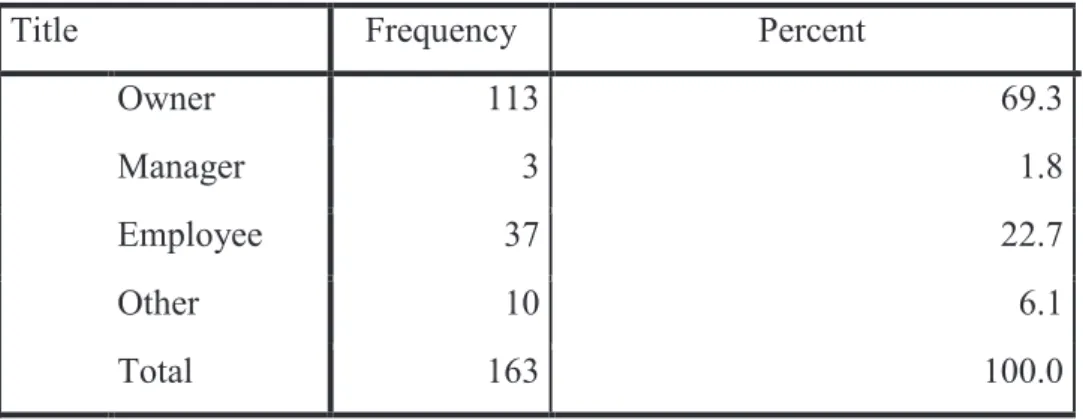
NORMALITY TEST
INDEPENDENT SAMPLE TESTING
Testing Respondents’ Opinions across Sex
This shows that the distribution of benefits is equal across gender lines, indicating whether one is male or female; the benefits of formalization are equally perceived. This shows that the distribution of barriers is not the same across gender categories, suggesting that perceived barriers to formalization differ depending on whether the respondent is male or female. The null hypothesis that the distribution of barriers is the same across gender categories is therefore rejected.
Testing Respondent’s Opinions across Position Held in Business
Testing Respondents’ Opinions across Academic Qualification
There was also a need to test whether there were significant differences between the means for more than two groups, as discussed in the next section. This indicates that benefits are perceived differently depending on the level of education achieved, while barriers are perceived the same regardless of educational qualification. There are statistically significant differences in benefits in relation to held educational qualifications, while there is a non-significant difference in barriers across held qualifications.
ENSURING VALIDITY
TESTING OVERALL RELIABILITY
Cronbach's Alpha, SCS (2011, p. 40) estimates it as no less than .6, while Kline (1999), quoted in Field (2009), argues that lower values are possible in psychology, where constructs are naturally too diverse . The best way to report reliability tests is to report the values of Cronbach's alpha as part of the factor loadings at the end of the factor analysis (Field, 2009, p.681). Subsequently, factor analysis was performed to identify the underlying barriers and benefits of formalization.
FACTOR ANALYSIS (FORMALISATION OF BUSINESS)
Factor Analysis: Benefits and Barriers to Formalisation of Business
- Benefits of formalisation (Factor Analysis)
- Factor Extraction
- Scree Plot
- Communalities
- Factor Loadings
- Naming of Factors and Interpretation
- Section B Reliability: Benefits of Registering Business
- Factor by Factor Reliability Testing
- Discussion of Analysis results: Benefits of Formalisation
- Barriers to Formalisation (Factor Analysis)
- Factor extraction
- Scree Plot
- Communalities
- Factor Loadings: Rotated Component Matrix
- Naming of Factors and Interpretation
- Section C Reliability: Barriers to formalization of business
- Factor by Factor Reliability Testing
- Discussion of Analysis Results: Barriers to Formalisation
In terms of internal consistency of the instrument measuring the benefits of formalizing firms, the questionnaire was found to be reliable (r=0.778), as shown in Table 4.10. The process resulted in the extraction of four components that acted as barriers to case formalization (Table 4.14), accounting for 58.279% of the explained cumulative variance and an eigenvalue >1. The amount of variance in each variable that can be explained by the conserved factors is reflected by the similarities in Table 4.15 (Field, 2009).
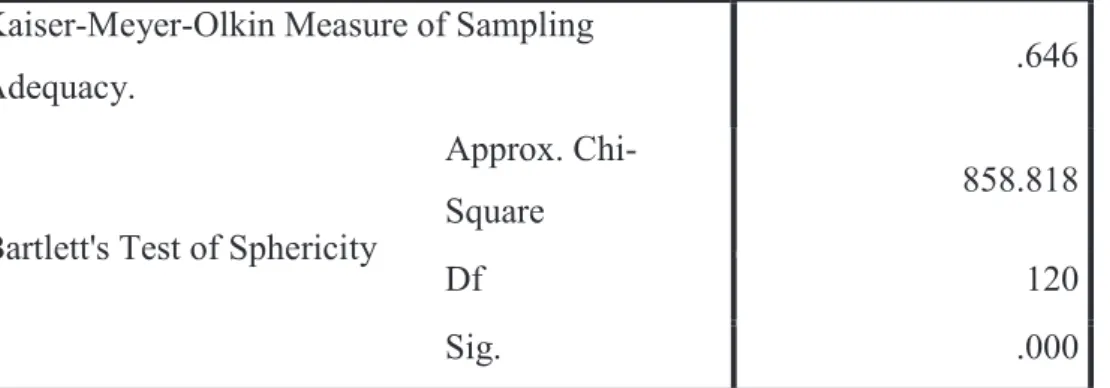
CHAPTER SUMMARY
The analysis culminated in Factor 1 labeled; Regulatory barriers, Factor 2 labeled Bureaucratic barriers and Factor 3 labeled Administrative barriers are retained. Poor administration was found to deter informal businesses from wanting to communicate with authorities. The use of factor analysis on the sample size was also found appropriate.
INTRODUCTION
CONCLUSIONS
Theoretical Objective of the Study
Empirical Objectives of the Study
- Empirical Objectives through Factor Analysis
- Empirical Objectives through Significance Tests
A factor analysis was conducted to identify the main constructs of formalization benefits and formalization barriers. It is also confirmed that the distribution of perceived benefits and obstacles to formalization is the same regardless of position in the company (Table 4.4). When testing the gender distribution of perceived barriers, it was found that there were statistically significant differences in what men perceived as barriers compared to women.
VALIDATION OF RESEARCH HYPOTHESES/ PROPOSITION
RECOMMENDATIONS
The government should simplify the way official business is conducted by reviewing and reducing paperwork and creating measures to establish a business culture in public offices. Permits and other legal requirements for permanent business premises should be reduced to encourage commitment. Government should engage key stakeholders and encourage commitment through business associations and peer review.
AREA FOR FURTHER STUDY
This study also established that the informal economy is a good source of government revenue and economic growth, but does not explore ways to utilize this revenue. Local Government Practices and Approaches to the Informal Economy- Learning Examples from Five African Countries., Johannesburg: SALED Network. Defining strategies for improving working and employment conditions in micro and small enterprises and the informal economy: Overview of the ILO learning and research agenda., Geneva: ILO.
Please indicate the extent to which you agree or disagree with the statement by ticking the corresponding number on a 5-point scale.
